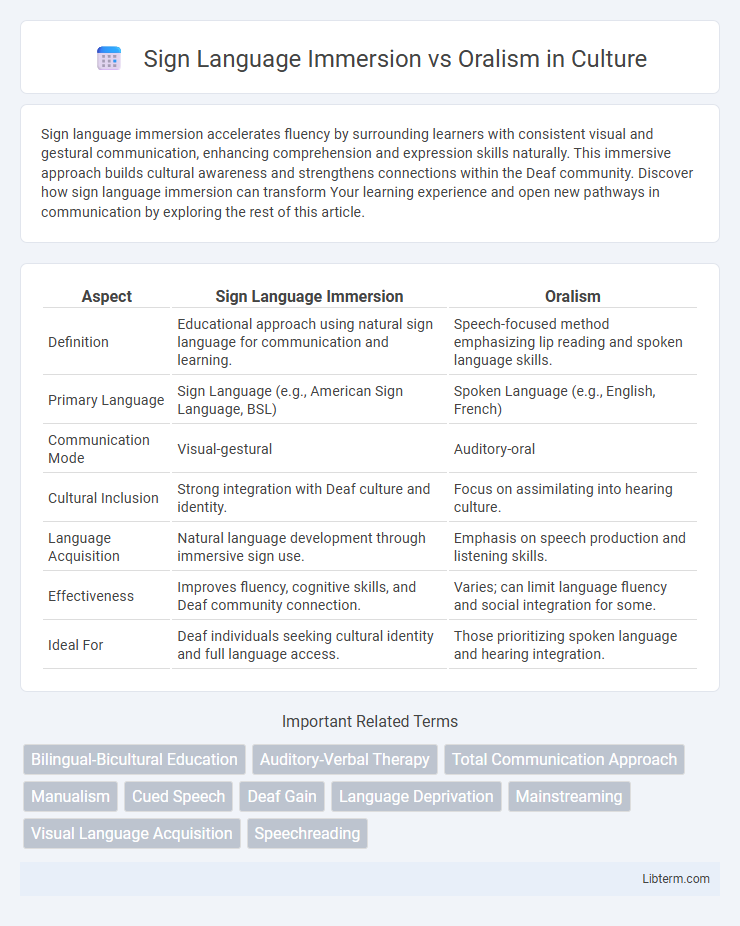Sign language immersion accelerates fluency by surrounding learners with consistent visual and gestural communication, enhancing comprehension and expression skills naturally. This immersive approach builds cultural awareness and strengthens connections within the Deaf community. Discover how sign language immersion can transform Your learning experience and open new pathways in communication by exploring the rest of this article.
Table of Comparison
| Aspect | Sign Language Immersion | Oralism |
|---|---|---|
| Definition | Educational approach using natural sign language for communication and learning. | Speech-focused method emphasizing lip reading and spoken language skills. |
| Primary Language | Sign Language (e.g., American Sign Language, BSL) | Spoken Language (e.g., English, French) |
| Communication Mode | Visual-gestural | Auditory-oral |
| Cultural Inclusion | Strong integration with Deaf culture and identity. | Focus on assimilating into hearing culture. |
| Language Acquisition | Natural language development through immersive sign use. | Emphasis on speech production and listening skills. |
| Effectiveness | Improves fluency, cognitive skills, and Deaf community connection. | Varies; can limit language fluency and social integration for some. |
| Ideal For | Deaf individuals seeking cultural identity and full language access. | Those prioritizing spoken language and hearing integration. |
Introduction to Deaf Education Approaches
Sign Language Immersion emphasizes the use of natural sign languages like American Sign Language (ASL) as the primary mode of instruction, fostering bilingualism and cultural identity within the Deaf community. Oralism centers on teaching Deaf students to develop speech and lip-reading skills, focusing on auditory-verbal training and integration into the hearing world. Both approaches impact language acquisition, cognitive development, and social inclusion differently, shaping Deaf education methodologies worldwide.
Understanding Sign Language Immersion
Sign Language Immersion emphasizes natural language acquisition through consistent exposure to sign language environments, fostering cognitive development and cultural identity in Deaf individuals. Research indicates that early immersion in sign language enhances linguistic proficiency and social-emotional growth compared to oral-only methods. This approach supports bilingualism and mitigates language deprivation risks often associated with exclusive oralism practices.
Exploring Oralism in Deaf Education
Oralism in deaf education emphasizes teaching speech and lip-reading skills to promote spoken language development, often prioritizing auditory-verbal methods over sign language use. This approach aims to integrate deaf individuals into hearing society by focusing on verbal communication, leveraging technologies like hearing aids and cochlear implants to enhance auditory access. Critics argue oralism may limit access to natural language acquisition and cognitive development without a strong foundation in sign language or other visual communication methods.
Historical Perspectives: Sign vs. Spoken Language
Historical perspectives on sign language immersion highlight its roots in Deaf communities valuing natural, visual communication, flourishing particularly after the 19th-century French Deaf education model pioneered by Abbe de l'Epee. In contrast, oralism, which emerged prominently in the late 19th and early 20th centuries, emphasized spoken language and lip reading, aiming to integrate Deaf individuals into the hearing world but often suppressing sign language use. The tension between these approaches reflects broader debates on language rights, identity, and educational efficacy in Deaf history.
Cognitive Benefits of Sign Language Immersion
Sign language immersion significantly enhances cognitive development by promoting improved spatial awareness, memory retention, and multitasking abilities through early visual language exposure. Research demonstrates that children immersed in sign language environments develop stronger executive function skills compared to peers relying solely on oralism methods. These cognitive benefits contribute to better problem-solving capabilities and academic performance, highlighting the advantages of sign language immersion in language acquisition.
Social and Emotional Impact of Oralism
Oralism, which emphasizes speech and lip-reading over sign language, often limits Deaf individuals' access to natural communication, leading to social isolation and emotional distress. The lack of fluency in a fully accessible language can hinder identity formation and reduce self-esteem among Deaf children. Studies highlight increased anxiety and depression rates linked to the social barriers created by exclusive oralism approaches.
Academic Outcomes: A Comparative Analysis
Sign Language Immersion programs consistently demonstrate superior academic outcomes for deaf students compared to Oralism, with higher literacy rates, improved cognitive development, and greater language proficiency in both signed and written languages. Research shows that sign language immersion fosters better comprehension and faster acquisition of complex concepts, contributing to enhanced performance in subjects like mathematics and reading. Oralism, which emphasizes speech and lip-reading without exposure to sign language, often results in delayed language acquisition and lower academic achievement levels.
Cultural Identity and Language Choice
Sign Language Immersion fosters a strong cultural identity by fully embracing Deaf culture and providing natural language acquisition within a community of native signers. Oralism, emphasizing spoken language and lip-reading, often limits access to Deaf culture, influencing language choice towards speech and potentially hindering linguistic and social development. Choosing between Sign Language Immersion and Oralism impacts not only communication skills but also cultural belonging and identity formation within the Deaf community.
Challenges and Criticisms of Each Method
Sign Language Immersion faces challenges such as limited access to qualified teachers and resources, leading to inconsistent language development in deaf children. Oralism is criticized for emphasizing speech and lip-reading at the expense of natural sign language acquisition, often causing delays in language and cognitive growth. Both methods encounter issues with inclusivity and communication barriers, impacting social integration and educational outcomes for deaf individuals.
Future Directions in Deaf Education Policy
Future directions in deaf education policy emphasize a balanced integration of sign language immersion and oralism to enhance bilingual proficiency and cognitive development. Research underscores the benefits of early sign language exposure for language acquisition while supporting oralism's role in speech and auditory training. Policymakers are increasingly advocating for inclusive curricula that accommodate diverse communication needs, promoting equity and academic success in deaf education.
Sign Language Immersion Infographic

 libterm.com
libterm.com